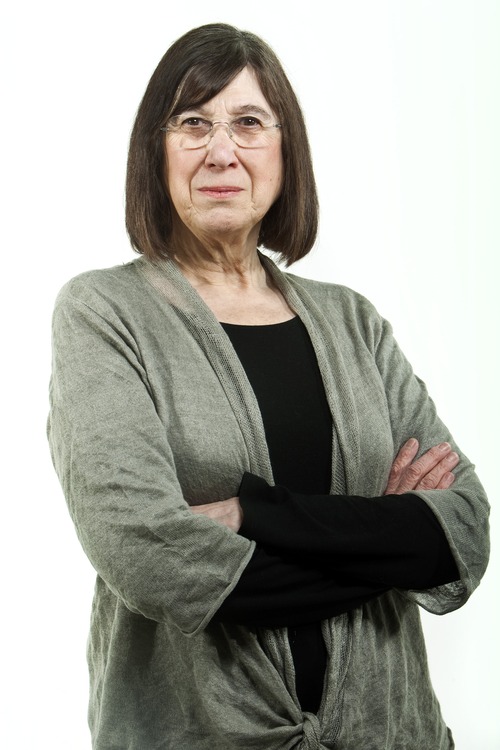This is an archived article that was published on sltrib.com in 2014, and information in the article may be outdated. It is provided only for personal research purposes and may not be reprinted.
As a child growing up in Maine and Boston, her mother told young Eileen she brought home whatever accent belonged to the children she was playing with.
Years later, history writer Eileen Hallet Stone has compiled a book's worth of local accents in The History Press book "Hidden History of Utah," a compilation of 58 columns first published in The Tribune.
"With Eileen, the bottom line is that she knows how to listen to people, to really hear them, and capture their stories and memories and joys and heartaches for her readers," says Peg McEntee, the former Tribune editor who hired Stone to contribute to the paper's "Living History" column in 2005. "Her attention to detail is phenomenal; she once wrote a history column about a canning plant that had me marveling at the intricacy of the machines as well as the tomatoes."
Getting the voices right is important to Stone, whether she has researched her subject's life by reading between the lines of an oral history or interviewed a survivor some years on. "It's almost like trying to listen with a third ear, to hear the real story, and to not put myself into it," Stone says.
In reading Stone's columns compiled into a book, "one story leads fluidly to another, capturing darkness and light in equal measure," McEntee says.
The book has sold steadily, says Catherine Weller, co-owner and book buyer at Weller Book Works. "Hidden History" has been in the top 10 books sold at The King's English Bookshop for the past four or five weeks. "We're always thrilled when people get excited about a local book," says Anne Holman, store manager.
The book includes stories of prostitution dens and frontier businessmen, of Pony Express riders and highway builders, of peach growers and celery farmers. Readers are likely to have heard of Utahns like Samuel Newhouse, who in 1907 bankrolled the Boston and Newhouse buildings on the south end of Salt Lake City's Main Street, or Simon Bamberger, the German immigrant who became Utah's first and only Jewish governor in 1916.
Yet among book's most vivid stories are those that have been more buried in Utah's history, like the women profiled in the "Headstrong" section.
Here, Stone tells the story of Uintah County's Josie Bassett (nee McKnight Ranney Williams Wells Morris), who was notable for her many last names and husbands, after being widowed and four times divorced (some believe she may have killed one of those husbands). Back when she was a teenager, Josie was remembered to have flirted with Butch Cassidy, when he worked at her father's ranch. But in 1914, Josie, then 40, homesteaded her own property, clearing brush and building a log house, where she lived for most of 50 years. As a 70-year-old grandmother, she took third place in a local horse race.
"She was so gutsy, it kind of threw me when I first heard about her," Stone says. She was kind to people, and very independent — in a way that's like the West. She exemplified Western life."
And then there's the story of Marie Ogden, who in 1933 founded a religious colony near Monticello, known as the Home of Truth. She turned to the occult as a way to remember her beloved husband, who had died of cancer. "She fascinates me," Stone says. "Here's a woman who had to find another way to live. She got into spiritualism, and believed God was speaking to her through her typewriter keys."
"Hidden History" also includes columns about life in Utah's west desert's Topaz Interment Camp, where Japanese-American citizens were imprisoned during World War II, and stories of Holocaust survivors, like Ernst Gunter Beier, a Jewish German immigrant who was captured during the Battle of the Bulge, and sent to the notorious German prison camp, Stalag 9B. Some instinct inspired him to quote from his beloved Faust, which he believed caused a feared Gestapo officer to save his life.
"Her columns on immigrants are particularly important in giving voice to all the people from all over the world who somehow made it to Utah and made Utah a better place with their presence," McEntee says.
Stone moved to Utah some 30 years ago, but it was when she started uncovering the distinctive and diverse characters in the state's history that she began to find a place for herself. "People say that they can see themselves in some of these stories," says Stone, also the author of "A Homeland in the West: Utah Jews Remember" and co-writer of "Missing Stories: An Oral History of Ethnic and Minority Groups in Utah."
And Holman adds another piece to the puzzle of why Utahns are so interested in reading about local history. Living here often feels like we are living in Small Lake City: In Utah, all of us seem to know somebody who knows somebody who once knew the person Stone is writing about.
facebook.com/ellen.weist —
History comes alive
Eileen Hallet Stone will read from her book "Hidden History of Utah" at 7 p.m. on Friday, Feb. 7, at Grounds for Coffee, 111 25th St., Ogden. Readings of 'Hidden History'
When • Saturday, March 1, 11 a.m. to 12:30 p.m.
Where • Costco, 1818 S. 300 West, Salt Lake City
When • Saturday, March 1, 2 to 3:30 p.m.
Where • Costco, 3747 S. 2700 West, West Valley City
When • Saturday, March 15, 11 a.m. to 1:30 p.m.
Where • Costco, 573 W. 100 North, West Bountiful



